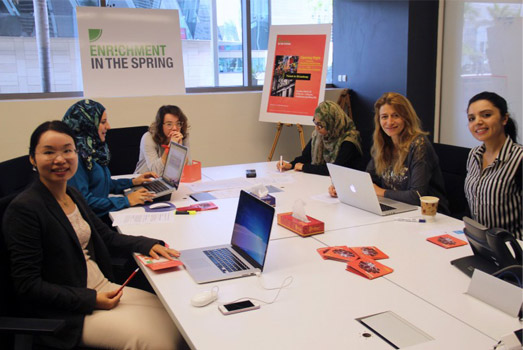Enrichment in the Spring opens KAUST minds to wonders of human brain

Prof. Pierre Magistretti speaking during Enrichment in the Spring.
KAUST’s first Enrichment in the Spring (SEP) program ran from March 20 – 28, introducing the entire KAUST community to the wonders of the human brain and mind, the themes of this year’s program.
Enrichment in the Spring featured lunchtime and keynote lectures on the latest neuroscience research, 3D visualizations of the brain, movies, exhibitions, concerts, board games and mind games in public spaces, enabling the KAUST audience to explore memory, emotion, language and all the functions of our amazing and complex brains. The program was held in conjunction with Brain Awareness Week, an international program celebrating the human brain, which ran from March 16-22 this year.
Neurotechnology to Advance Brain Research
Invited speaker and world-renowned neuroscientist Professor Alim-Louis Benabid, 2014 recipient of the Lasker-DeBakey Clinical Medical Research Award and 2015 recipient of the Breakthrough Prize in Life Sciences, gave a SEP keynote lecture describing the approach of neurosurgical pathologies.
Benabid helped found Clinatec, a multidisciplinary research center located in Grenoble, France, where scientists implement new developments in the field of neurotechnology through micronanotechnology-based innovations in diagnosis and medicine. In his lecture, Benabid outlined how the synergistic work of scientists, engineers and physicians is helping advance neurotechnology approaches to combat brain diseases.
Visualization Technology and the Brain
KAUST Visual Computing Center Ph.D. student Ali Awami and postdoctoral fellow Corrado Cali enlightened the KAUST audience on the ability of visualization technology to help in the study of brain structure and function. In their lecture and presentation session, Awami and Cali outlined KAUST’s collaborative projects with the Human Brain Project and the Human Connectomics Project.
KAUST and École Polytechnique Fédérale de Lausanne (EPFL, Switzerland) are participating in an Alliance for Brain Metabolism and Visualization, which is connected with the Blue Brain Project of EPFL and the Human Brain Project. The long-term goal of the project is to develop a comprehensive and accurate model of the nervous system.
Awami and Cali described how KAUST researchers are collecting a new experimental dataset that aims to reconstruct the morphology of all the non-neuronal cells in the brain and the brain’s vasculature. This will help in increasing the complexity and refining the accuracy of the existing model. KAUST researchers are also working to create novel solutions to visualize large-scale connectome data in an ongoing project with Harvard University.
The KAUST audience was also treated to a tour of the Visualization Lab, where they experienced Cave-Cornea and NexCave’s 3D environments. There they saw the forest of axons and dendrites making up the brain, helping them to understand the details of KAUST and its partners’ neuroscience projects.

The Office of Enrichment Program team organizing the program events
Multimedia Presentation Moves Audience
Pierre Magistretti, KAUST Dean of Biological and Environmental Science and Engineering, and guest composer and musician Michael McGinnis presented a special SEP multimedia and music event entitled “Emotion, Music and the Brain,” which examined how our brains process and respond to emotions.
McGinnis composed and played music he associated with a particular emotion, such as fear, anger, surprise and happiness. The music was paired with images of people expressing each emotion, with images and music coming together for a truly interpretive and multisensory experience for audience members.
Dean Magistretti provided an introduction to the evening with a lecture outlining the neurobiological basis of emotions.
“I explained how we perceive emotions, what parts of the brain are engaged in this, and the fact that a brain without a body cannot generate emotions. The brain detects our bodily state during an experience and this is what provides the emotional component to it,” Magistretti explained.
Communicating Science to the Public
Magistretti was one of the promoters of the first Brain Awareness Week in Switzerland in 1998.
“Brain Awareness Week spread throughout Switzerland on the basis of engaging scientists with the public in dialogue around brain research,” said Magistretti. “We neuroscientists wanted to make an effort to communicate to non-specialists the progress in brain research in the broadest terms. Our goal was to establish a dialogue between the general public and the scientists.”
Connecting Brain Awareness Week with SEP was a “wonderful idea,” Magistretti noted, as it was an opportunity to share neuroscience in an accessible way with a general audience.
“I have been working in advocacy and public understanding of science for many years, and I feel we scientists must be committed to sharing our passion about what we do and why it is important, and also to provide feedback to society at large abut the resources that are engaged in research through public and private funding,” he said.
- by Caitlin Clark, KAUST News

